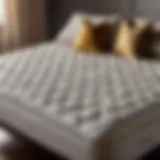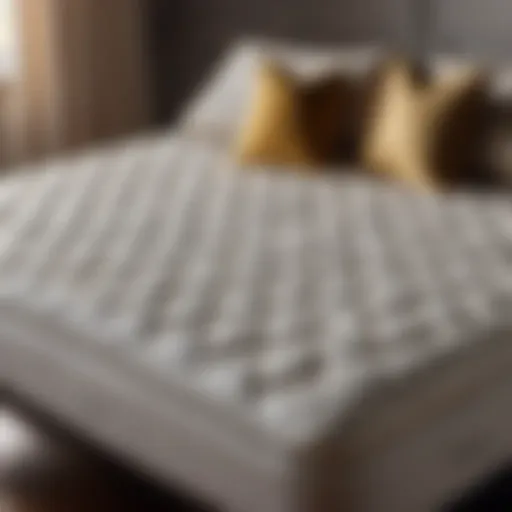Non-Toxic Paint for Bird Baths: A Complete Guide
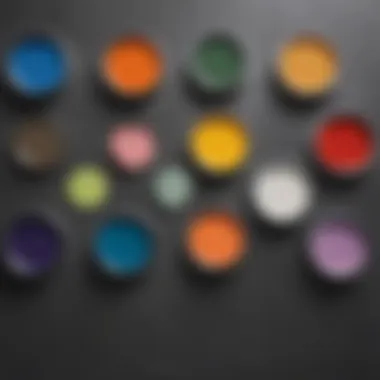

Intro
When it comes to enhancing the vibrancy of outdoor spaces, bird baths hold significant appeal. Not only do these water features attract wildlife, but they can also be personalized to fit distinct aesthetic choices. However, safety must come first, especially when these features involve paints, which can often contain harmful toxins. That is where non-toxic paint options come into play. This guide aims to detail each factor involved in making your bird bath safe for the environment while also increasing its aesthetic value.
Materials:
To embark on your project, select materials that prioritize the safety of birds and the surrounding ecosystem. Here’s what you will typically require:
- Non-Toxic Paint:
- Protective Coat:
- Brushes:
- Sandpaper:
- Rags or Cloths:
- Water Container:
- Paint Palette:
- Drop Cloths:
- Choose a high-quality non-toxic acrylic paint. Purchase approximately two to three 8-ounce containers, depending on the size of your bird bath.
- Consider a clear, non-toxic clear sealant. One 8-ounce container should suffice.
- A variety of brushes can lead you to nicer detail handling. Include a 1-inch brush, a small detail brush (around 0.5 inches), and a foam brush.
- A medium grit (120-150) may be needed to prepare the surface.
- Keep a few old cloths handy to clean off excess paint and for sealing.
- You will want an appropriate size, like a small bucket or basin, for rinsing your brushes.
- A simple plate or tray to mix colors.
- Clear space by using one or two drop cloths to catch any spillage.
Always remember to conduct a site check before commingling your workspace with anything that might distract the bird’s presence.
DIY Steps:
Here are precise and straight-forward steps to achieve a pleasing and bird-safe finish on your bird bath.
- Preparation:
Set your project area by covering surfaces with drop cloths and gathering your materials. Ensure proper ventilation if working indoors. - Clean the Surface:
Use water and rags to scrub the bird bath and remove any dirt or debris. Let it dry thoroughly. - Sand the Surface:
Smooth any rough spots on the bath surface with moderate grit sandpaper. Eventually, it will help with paint adhesion. Cleanup with a damp cloth afterward. - Paint Application:
Use the larger brush for broad strokes and base layers, and let it dry before adding another. After, extend your effort to smaller brushes and apertures. It’s helpful to consult your palette for any creative mixtures before brushing on walls - enticing color taps can increase nuances! - Secure with Sealant:
Once your paint is dry for roughly 24 hours, apply the non-toxic clear coat for added protection. This will safeguard your color and surface against the elements while ensuring it's bird-friendly. - Drying Time:
Allow a drying time of at least 24 hours after applying the sealant before placing the bath outdoors.
Technical Aspects:
Understanding the tools and timings can take your DIY experience to the next level. Here’s a quick breakdown:
- Tools Required:
- Timing:
- Critical Techniques:
- Paintbrushes (various sizes)
- Sandpaper (medium grit)
- Rags
- Paint containers
- Water container
- Expect to spend 1-2 hours on preparation and initial painting.
- Drying can vary based on humidity but expect a minimum of 48 hours before outdoor usage.
- Use thin layers of paint; thick application takes longer to dry and may cause peeling.
- Work in a shaded area to control drying times, ensuring the paint sets properly without being affected by direct sunlight.
DIY process:
This is the step-by-step installation method overall to maintain neat aesthetics and functional relevance:
- Installation Process:
Position the bird bath securely in your garden premises. Ensure its stable and fortified basis, unyielding from likely nature interference. - Highlighting Techniques:
Engage in sparing creativity; accents cordially measure attention to small features unique to local birds that may benefit indirectly through show design.
Troubleshooting Tips:
Common challenges could arise during operation. Below are helpful methods to sidestep or resolve these problems:
- Runs or Drips in Paint:
This may occur if bleeding edges accumulated while paint fluid maintained uniform density. Immerse materials throughout layers prompting physics advice on striation controls. - Sealing Issues:
If sealants fail or correspond negatively, contributing toxins might breach elsewhere, check for consistency before operating. Adjust circumstances tightly - renew intervals while covering inaccurately porous coatings may assist longevity.
Properly applied non-toxic paints enhance safety and visual appeal, making our feathered friends thrive instead of trivially suffering.
Through these steps, you can create a stunning and safe bird bath that enhances your garden while ensuring that not only the aesthetics but bird welfare is considered and celebrated.
Prolusion to Non-Toxic Paint
In the quest for nurturing outdoor havens, non-toxic paint becomes an essential topic for bird baths. The vibrant colors can enhance the aesthetics of the bath while ensuring the safety of ecosystems surrounding us. Knowing why non-toxic options are crucial satisfies a broader mission: creating an environment free of hazards.
Understanding Non-Toxic Paint
Non-toxic paint is formulated without harmful chemicals. It is safe for humans, pets, and, notably, birds. Common ingredients in traditional paints can release volatile organic compounds (VOCs) that may be harmful. Non-toxic paints often utilize water-based, plant-based, or natural mineral formulations. By opting for these selections, the integrity of the outdoor habitat is upheld.


Key features of non-toxic paint include:
- Low or no VOC content: This minimizes impact on air quality and health.
- Eco-friendly materials: Sourced from nature or bioproducts, promoting sustainability.
- Durable finishes: Specially designed to withstand weather conditions while maintaining aesthetics.
An informed choice creates a positive ripple effect, protecting wildlife and enhancing personal outdoor spaces.
Why It Matters for Outdoor Use
Using non-toxic paint outdoors is about safeguarding habitats. Bird baths serve multiple purposes, attracting wild birds and enhancing landscapes. Traditional paints expose wildlife to toxic substances that resist natural decomposition.
When choosing paint for an outdoor setup, consider these impacts:
- Safety for birds: Birds come into close contact with both the paint and the water within. Non-toxic paints significantly decrease risks.
- Environmental preservation: Reducing chemical pollutants aids in sustaining diverse ecosystems.
- Longevity of painted surfaces: Quality non-toxic formulations provide excellent durability multi-seasonal.
Health Risks of Toxic Paints
Understanding the health risks associated with toxic paints is crucial, especially if you place bird baths in your backyard. Many conventional paints contain harmful substances that can adversely affect not just birds but also local wildlife and humans alike. Identifying these risks supports informed choices when selecting paints. The environmental implications extend beyond individual health; they influence overall ecosystem health as well.
Impact on Birds and Wildlife
Toxic paints present significant dangers to birds and wildlife. When exposed to harmful chemicals, birds may experience various health issues. These can range from impaired neurological functions to failure to thrive. Common toxic ingredients include lead, volatile organic compounds (VOCs), and heavy metals. These materials can affect birds through inhalation, ingestion, or absorption during nesting or bathing.
Additionally, the implications for the broader ecosystem are concerning. Lethal poisons can enter the food chain. When birds interact with contaminated environments, they may inadvertently harm other species too. Such repercussions illustrate the critical need for selecting non-toxic materials. It fosters safer habitats for local fauna, ultimately using non-toxic paint enhances sustainability.
- Non-toxic options encourage wildlife conservation while improving individual bird health.
Potential Hazards to Humans
Humans too are susceptible to the toxic effects of paints. Many paint solvents release harmful fumes that pose risks during application and curing. Symptoms can include headaches, dizziness, and, in significant cases, liver or kidney damage. Vulnerable groups like children, pregnant women, and elderly individuals might face heightened risks.
Recent regulations aim to reduce these hazards by restricting certain toxic substances in paints. However, many inferior products still circulate in the market. Scrutinizing labels and understanding the ingredients is essential. Accepting any level of harmful content needs avoidance.
Employing non-toxic paint contributes to healthier living conditions. When repainting outdoor items like bird baths, prioritize your family’s health and wellbeing in addition to protecting the environment.
Types of Non-Toxic Paints
In the quest for a safe and appealing bird bath, understanding the types of non-toxic paints available is essential. Choosing the right paint directly influences the health of both birds and humans who interact with these decorative pieces. There are various non-toxic options to consider, each with unique properties, benefits, and considerations.
Among the different types, three prominent categories usually stand out: water-based paints, plant-based paints, and natural mineral paints. Each type possesses specific advantages and is appropriate in various scenarios depending on personal preferences, ecological impacts, and desired aesthetics.
Water-Based Paints
Water-based paints are increasingly favored for their convenience and ecological benefits. These paints are predominantly made with water as a solvent and are usually lower in volatile organic compounds (VOCs) than oil-based paints. This quality significantly reduces risks of air pollution during application, making their usage preferable for outdoor items like bird baths.
Water-based paints dry quickly and can easily be cleaned up with soap and water, which adds a layer of practicality to any project.
When selecting water-based paints, look for brands that explicitly emphasize their non-toxic formulations. These paints should be certified safe for outdoor use and compliant with environmental guidelines. The finish can vary, providing choices ranging from matte to glossy textures.【/b】
Plant-Based Paints
Plant-based paints are crafted from natural ingredients, including oils and resins sourced from plants. These paints do not contain harmful chemicals commonly found in synthetic alternatives. Utilizing plant-based paints delivers an array of benefits, such as biocompatibility, promoting a healthier surrounding for both birds and humans.
The most notable feature of plant-based paints is their breathability. This allows the painted surfaces to respond well to changes in humidity and temperature, thus preserving their condition over time.Commonly available plant-based options include linseed oil, soy-based formula, and even clay mixtures.
When considering this type of paint, evaluate the intended color and sheen. Not all plant-based paints deliver rich pigmentation compared to their synthetic counterparts, thus limiting choices if vividness is a priority.
Natural Mineral Paints
Natural mineral paints, composed of inorganic minerals and earth pigments, distinguish themselves through unique durability and aesthetic qualities. They are entirely non-toxic and resistant to mold, ensuring they maintain their look even in turbulent weather conditions.
One major consideration with natural mineral paints is their porous nature, which allows for unique visual textures. They provide a distinctive, rustic charm that appeals to many homeowners wishing to enhance their garden or outdoor space.
These paints are also UV resistant and often long-lasting, making them suitable for environments exposed to sunlight.
When applying any type of non-toxic paint, remember to verify its specifications and protections suitable for the material your bird bath is made of, as it can affect longevity and look. Be mindful in the process because how one paint type fares over time will impact its performance and safety for feathered visitors.
Choosing the Right Paint
Selecting the appropriate paint for your bird bath is a crucial consideration. The right paint ensures not only the aesthetic appeal of the bird bath but also the health and safety of the birds visiting it. With multiple non-toxic options available, you need to pay attention to specific elements like labeling and certifications. Understanding how to evaluate both quality and environmental impact is important in making an informed choice that aligns with your values and practical needs.
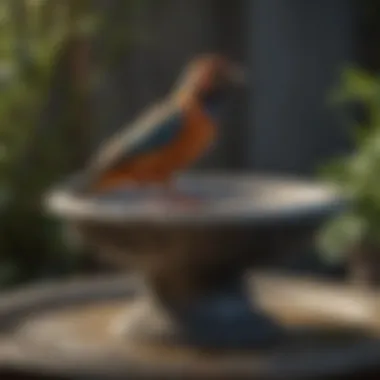

Analyzing Labels and Certifications
When reviewing paint options, it is essential to consider product labels and their certifications. Look for paints that are labeled as non-toxic or environmentally friendly, as these terms indicate compliance with safety standards. Certifications from organizations like the Green Seal or the Environmental Protection Agency (EPA) can further guarantee that the paint has been rigorously tested for safety.
Ensure that the paint is free of harmful substances such as lead and volatile organic compounds (VOCs). Products marketed as low-VOC reduce harmful emissions and are safer for wildlife and humans alike. Check the contents list carefully; there should not be any ingredients that could leach into water and harm the birds.
An effective way to ensure the paint meets health standards is to cross-reference products on trusted consumer safety databases. Look for detailed reviews and feedback related to the safety of paints before making a purchase.
Evaluating Durability and Finish
Paint durability is another vital aspect to assess. Outdoor elements such as rain, sunlight, and temperature fluctuations can cause wear and tear to painted surfaces. Therefore, a long-lasting finish is important. Durable non-toxic paints should withstand these outdoor conditions without peeling, fading, or washing away. Read reviews to gauge performance and potential longevity of the product under real-life conditions.
The finish of the paint also plays a role. Some prefer a matte texture for a natural appearance, while others may choose a glossy finish for a sleek look. Glossy finishes can be easier to clean but may not mimic the more natural look surrounding gardens. It's advisable to ask about specific products or tips from fellow DIYers or on forums like reddit.com, where many share their firsthand experience.
Before making your decision, take into account how often you want to redo the paint. Choosing a highly durable and aesthetically pleasing paint initially can save you time and effort in ongoing maintenance.
Ultimately, the right paint for your bird bath should ensure aesthetic contribution alongside health and safety for the birds, balancing beauty and peace of mind in outdoor decor.
Preparing the Bird Bath for Painting
Preparing a bird bath for painting is a crucial phase in achieving a durable and aesthetically pleasing outcome. This section will guide homeowners through the necessary steps to ensure that the surface is clean and equipped for a successful paint application. Proper preparation not only enhances the appearance but also extends the life of the painted surface.
Cleaning and Repairing the Surface
The first step is to clean the surface thoroughly. Dirt, grime, and old paint can inhibit the adhesion of the new paint. Start by removing any loose material; a gentle scrub with a brush and water is often effective. For stubborn residue, a mixture of water and mild detergent may be useful. Rinse well to eliminate any soap left behind.
Important notes:
- Allow the bird bath to dry completely before starting the painting process. This prevents moisture from being trapped beneath the new paint.
- Repair any cracks or chips to ensure a smooth painting surface. Depending on the material of the bird bath, you might use either a suitable sealant or an epoxy resin designed for outdoor use.
Steps for Surface Repair:
- Identify damaged areas and clean them properly.
- Apply the chosen repair material and smooth it out.
- Let the repair set for the recommended time.
Taking time for the essential step of cleaning and repairing lays a strong foundation for achieving the best results with your chosen non-toxic paint.
Selecting the Right Environment
The environment in which you paint does impact the outcome. Starting the painting project in an area with controlled weather conditions will yield better results. Here are key considerations for selecting your workspace:
- Temperature and Humidity: It is advisable to paint when the temperatures are mild and humidity levels are low; this ensures even drying and better adhesion.
- Ventilation: If you’re working indoors, ensure good airflow to disperse any VOCs, even with non-toxic options. Line the workspace with protective covers to prevent unintended paint spills.
- Sun Exposure: Avoid direct sunlight while painting. Excessive heat can dry the paint prematurely. Try to find a shaded area if you’re working outside.
A well-prepared bird bath and a thoughtfully selected environment lead to rewards in your painted bird bath— both visually and functionally.
Painting is not merely about the final look. It's a careful process that guarantees safety for birds and improves our outdoor spaces.
Application Techniques
Application techniques play a crucial role in successfully implementing non-toxic paint on bird baths. Proper techniques can ensure that the paint adheres well, offers durability, and withstands the outdoor elements. Understanding how to correctly apply paint not only enhances the appearance of your bird bath but also safeguards the well-being of visiting birds and local wildlife.
Tools and Equipment Needed
When preparing to paint a bird bath, selecting the right tools and equipment is vital. Here are some necessary items you should consider:
- Paint Brushes: Use high-quality brushes for even coverage. Natural bristles generally work well for water-based paints.
- Paint Rollers: For larger surfaces, rollers can provide a smooth and fast application. Use small ones for precision around edges.
- Drop Cloths: Protect surrounding areas with drop cloths to catch any stray paint.
- Masking Tape: This helps outline areas and creates clean lines, especially when working with multiple colors.
- Paint Tray: A tray will help you manage your paints effectively.
- Sandpaper: Use fine-grit sandpaper for smoothing surfaces before painting.
- Soap and Water: Essential for cleaning your brushes and tools afterward.
- Protective Gear: Don't forget to wear gloves and masks to protect your health while working with paint.
Layering for Coverage
Layering is critical in achieving an even and long-lasting finish. The benefits of layering non-toxic paint include a richer color and better protection against the elements. Here are some important points to consider:
- Start with a Primer: If the surface requires it, a primer can be helpful for both adhesion and coverage.
- Thin Coats: Apply thin coats rather than one thick layer. Thin layers dry more evenly and reduce the risk of drips and runs.
- Wait Between Coats: Each layer should be allowed to dry fully according to the manufacturer's guidelines before applying the next coat. This prevents muddying of colors and helps maintain the vibrancy. A general rule of thumb is to wait at least 1-2 hours before applying another coat.
- Final Sealant: Once the colored layers are fully dried, consider applying a topcoat or sealant for added protection, especially if the bird bath will experience rain. This enhances durability against the elements.
Remember, patience during layering often results in a stunning finish.
Drying and Curing Time
Understanding drying and curing times is essential to ensuring your paint job is durable and effective. Here are the main points:
- Dry Time vs. Cure Time: Drying refers to surface dryness and can occur quickly, typically within 1-2 hours depending on factors such as temperature and humidity. Curing, on the other hand, is the complete hardening of the paint, which can take from several days to weeks based on the specific product.
- Environmental Factors: Temperature and humidity can affect drying time significantly. Avoid painting in high humidity or extreme temperatures to ensure ideal conditions for drying.
- Frequency of Use: Be mindful that while the paint may feel dry to the touch, it may not be fully cured. It's best to allow at least a week before exposing the bird bath to constant use and contact with water.
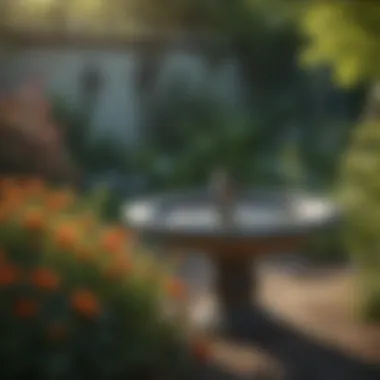

By following these application techniques, your commitment to a safe, aesthetically pleasing bird bath will not only beautify your year drive, but it will also offer kindly haven for various species, contributing positively to your local environment.
Maintaining Your Painted Bird Bath
Maintaining your painted bird bath is essential for ensuring its longevity and effectiveness. Once the bird bath is coated with non-toxic paint, it is not only a safe choice for the environment, but it also serves as an attractive feature in your garden or yard. Regular care can significantly increase the lifespan of the paint and the overall functionality of the bird bath.
Active maintenance prevents degradation due to weather, sunlight, and natural wear and tear. Furthermore, well-maintained bird baths create a safer habitat for wild birds. Clean, functional water sources are vital for birds. A neglected bird bath can become a breeding ground for algae, harmful bacteria, and pests, undermining its purpose.
Regular Cleaning Best Practices
Regular cleaning is one of the critical aspects of maintaining your painted bird bath. Pollutants, debris, and organic matter can accumulate often leading to unsightly stains or worse, health hazards for birds. Here are some best practices for maintaining cleanliness:
- Frequency: Clean your bird bath weekly to prevent algae growth. In hot weather, consider cleaning every few days.
- Cleaning Solutions: Choose a gentle, soap-free cleaner or a mixture of vinegar and water. Avoid harsh chemicals, as these can damage both the paint and harm birds.
- Cleaning Method:
- Remove the water and debris.
- Scrub with a sponge or soft brush. Focus on hard-to-reach corners.
- Rinse thoroughly to ensure no cleaner residue remains.
- Refill with fresh water afterward.
This cleaning process will support the vibrant appearance of your painted bath while keeping it friendly for the wild birds.
Inspecting for Damage
Inspecting your painted bird bath for damage is equally indispensable. Over time, weather conditions can wear down the paint, crack the surface, or lead to peeling. Identifying damage is crucial for timely addressment and prolonging the life of your bird bath.
Consider these steps during your inspection:
- Visual Checks: At least once a month, visually inspect for any signs of peelng, chipping, or discoloration in the paint. Examine well.
- Surface Integrity: Run your hands over the surface to feel for rough areas or cracks. If paint shows signs of wear, it may require repair.
- Seasonal Treatment: Before the winter season, perform thorough checks. Cold weather can exacerbate damage, so restoration is necessary before harsher elements arrive.
By making vigilant inspections, you can catch minor issues early, potentially saving you from extensive repairs later. Taking these proactive measures contributes to the health of arriving birds in your space year-round.
Aesthetic Considerations
Aesthetic considerations play a vital role in the choice and application of non-toxic paint for bird baths. A well-painted bird bath does not just fulfill a functional requirement; it enhances the overall charm of your outdoor space. By understanding proper aesthetics, you can create an environment that is both welcoming for birds and visually pleasing to you as a homeowner. It allows for self-expression while simultaneously promoting wildlife conservation.
There are key elements in aesthetic considerations for painting bird baths, including color selection and custom artistic designs. These elements can positively influence how your bird bath fits into your garden or patio area.
One benefit of focusing on aesthetics is the ability to complement existing decor or greenery in your space. The colors and patterns you choose can highlight seasonal variations while encouraging birds to visit, as vibrant colors attract them.
Color Choices and Effects
When selecting colors for your bird bath, consider the location and the surrounding environment. Light, pastel shades might blend beautifully in a floral garden, while bold colors can stand out against leafy backgrounds. Neutral tones can bring a sensation of tranquility, offering a brilliant contrast to lively garden blooms.
Furthermore, different colors evoke various emotional responses. Blues and greens are calming, while reds and yellows can introduce energy and vivacity. This can enrich your outdoor experience significantly, cultivating an enjoyable atmosphere.
To achieve an aesthetic that delights both birds and humans, here are some key points to consider:
- Context: How does the color match with nearby flowers, grass, or houses?
- Theme: Do you prefer a unified color scheme or eclectic color pairing?
- Bird Attraction: Certain birds may be drawn to particular colors, potentially affecting bird visits.
Most importantly, ensure the colors you pick are non-toxic and formulated for outdoor use. This safeguards the health of the wildlife while also looking great outside your home.
Artistic Techniques for Custom Designs
Artistic techniques can turn a standard bird bath into a true statement piece. Applying various methods allows for personalized touches that reflect your style or resonate with wildlife life themes.
Techniques can range from simple to more involved, requiring different skills. Here are a few artistic strategies you can implement:
- Stencils and Templates: Easy to use for uniform designs;
- Sponging or Rag Rolling: Produces a textured feel;
- Dot Painting: Adds fun detail while giving a vibrant look;
- Mosaic Patterns: Colorful and appealing, allowing varied materials outdoors.
By experimenting with these methods, you can find out what complements your bird bath, fitting perfectly with your garden decor. Investing time and thought into aesthetics aligns with the broader objectives of protecting birds and making outdoor spaces enjoyable.
Ultimately, the effort pays off; a stunning bird bath not only attracts feathered friends but can also uplift your exterior round the year.
Epilogue
Understanding the significance of using non-toxic paint for bird baths is integral to fostering a safe and vibrant environment for both our feathered friends and our homes. In this guide, we have explored various safe paint options, emphasized the potential risks associated with toxic paints, and outlined best practices for application and maintenance. Each step has been designed to maximize health benefits while providing creative freedom in aesthetics.
The awareness of using non-toxic paints ensures that the beautiful designs you masterfully apply to your bird baths do not inadvertently harm the wildlife or the environment. By considering the implications of each choice, you promote not only the welfare of birds but also commendably contribute to a broader eco-conscious lifestyle.
Summarizing Key Takeaways
- Eco-Friendliness: Non-toxic paints are essential for keeping outdoor areas safe for birds and other wildlife. They avert chemical harm, allowing birds to bath safely in these spaces.
- Variety of Options: The availability of different non-toxic paint types, such as water-based, plant-based, and natural mineral paints, caters to varied artistic preferences while maintaining safety.
- Preparation is Key: Thorough cleaning and preparing the surface of your bird bath before painting significantly impact the longevity and quality of the finish.
- Aesthetic Freedom: You can opt for custom colors and artistic techniques, ensuring your creation not only invites birds but also complements your home’s decor seamlessly.
Promoting Safe Practices in Home écor
Choosing to use non-toxic paints echoes your commitment to health in home decor. It is crucial to reference labels and certifications when finishing your bird bath to ensure they meet safety standards. Integrating safe practices further encourages a responsible attitude toward home improvement and encourages a happier, healthier living dynamic. Here are simple practices to follow:
- Always read labels carefully to avoid harmful compounds.
- Opt for paints with third-party certifications that ensure non-toxicity.
- After painting, let bird baths cure adequately before introducing them back to outdoor use to ensure maximum safety.
Using eco-friendly materials promotes both an aesthetic enhancement and peace of mind, knowing you are nurturing a safer environment. Implementing these safe practices is commendable not just for you as a homeowner but also promotes broader community and environmental health.






